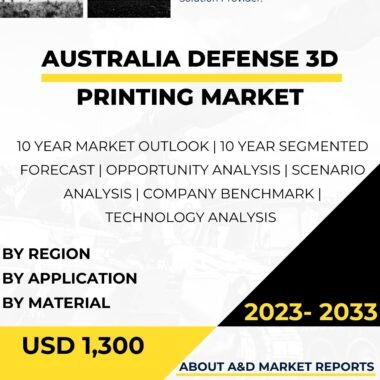Description
The United Kingdom’s defense sector has been exploring the potential of 3D printing technology, also known as additive manufacturing, to revolutionize various aspects of military operations and equipment development. 3D printing enables the creation of complex and customized components with reduced lead times and costs, offering significant advantages to the defense industry. As the technology matures, the UK defense 3D printing market is witnessing steady growth, with increasing adoption and investment in research and development.
The defense industry in the UK has identified numerous applications for 3D printing, ranging from prototyping and rapid tooling to manufacturing spare parts and even end-use components for military equipment. The ability to rapidly produce prototypes allows for quicker design iterations and validation, expediting the development process for new weapons systems and other defense platforms. Additionally, 3D printing facilitates the production of low-volume, high-complexity components that are challenging to manufacture using traditional methods.
One of the main advantages of 3D printing in the defense sector is its potential to enhance supply chain resilience. By decentralizing manufacturing capabilities and producing parts on-demand, the military can reduce dependence on a vast network of suppliers, making it less susceptible to disruptions caused by geopolitical tensions or logistical challenges. This capability is particularly critical for maintaining operational readiness and reducing downtime for military equipment.
Moreover, 3D printing can lead to cost savings in the long run. While the initial investment in 3D printing infrastructure and equipment may be significant, the ability to produce spare parts and components locally can significantly reduce logistics and transportation costs associated with traditional supply chains. Additionally, 3D printing enables the optimization of component designs, reducing material wastage and associated expenses.
3D printing enables the production of highly intricate components that would be challenging or even impossible to manufacture through conventional methods. This capability is of particular interest in the aerospace and defense sectors, where lightweight and complex parts can improve the performance of aircraft and military vehicles. Components with internal lattice structures can be produced, reducing weight without compromising strength. This weight reduction can lead to increased fuel efficiency and extended operational ranges for military assets.
The UK defense sector, like many others, is increasingly conscious of the environmental impact of its operations. 3D printing offers potential sustainability benefits by reducing material waste and energy consumption compared to traditional manufacturing processes. By only using the material necessary for the 3D printed part, less waste is generated, making it an eco-friendly manufacturing option.
Despite the advantages, 3D printing also presents challenges for the defense sector. One major concern is the potential risk of unauthorized production and counterfeiting of military equipment. The ease of access to digital designs and 3D printing technology may make it easier for malicious actors to replicate critical components. Ensuring the security of 3D printing processes and protecting intellectual property rights becomes a priority for defense manufacturers and the armed forces.
To ensure the integrity and reliability of 3D printed components, establishing standards and qualification processes is crucial. Components manufactured through 3D printing must undergo rigorous testing and validation to meet the stringent requirements of the defense industry. Collaborative efforts between defense contractors, government agencies, and regulatory bodies are essential to develop comprehensive standards for additive manufacturing in defense applications.
Recognizing the transformative potential of 3D printing in defense, the UK government and defense industry stakeholders are investing in research and development to advance the technology further. Collaborations between academia, industry, and government institutions have led to innovative projects exploring new materials, processes, and applications for 3D printing in defense.
In conclusion, the United Kingdom’s defense 3D printing market is witnessing continuous growth, driven by its potential to enhance supply chain resilience, reduce costs, and enable the production of complex components. While security and intellectual property concerns remain, efforts are underway to develop robust standards and qualification processes. As 3D printing technology continues to evolve, it will play a crucial role in shaping the future of the UK’s defense industry, enabling greater innovation, efficiency, and sustainability in military operations and equipment development.




